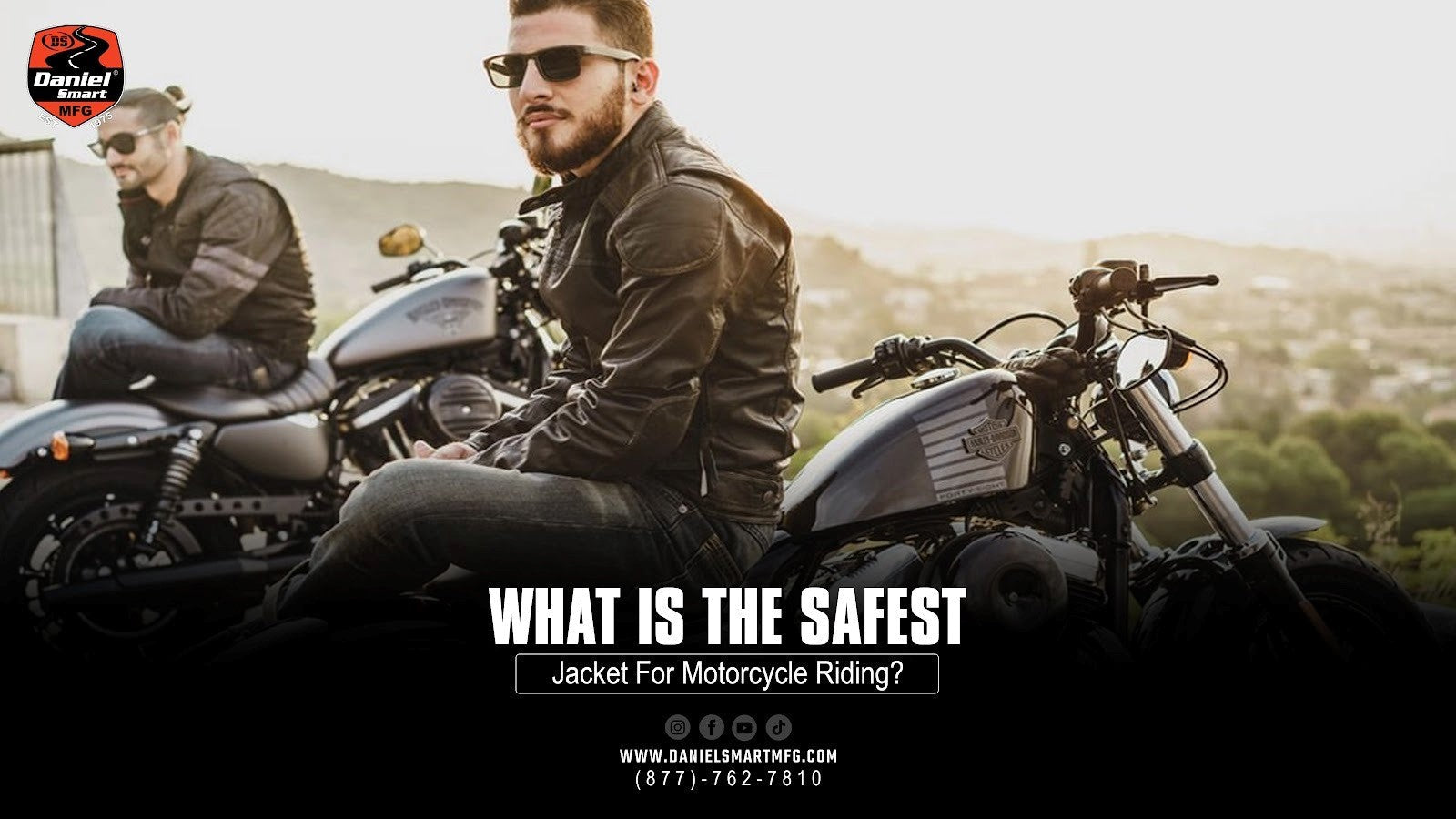Riding safety isn’t guaranteed just because you’re careful on the road. Also, if you are too careful while riding, you are probably not enjoying it.
To fully experience the adventure and adrenaline rush, you must focus on speed and the road rather than worrying about safety.
But safety is significant too. This is why you need the safest jacket for motorcycle riding. How do you know if the jacket is safest? There are several factors to consider.
Let us help you find the right kind of jacket you need.
We will discuss material, protective features, comfort, and many other aspects, so you can determine which jacket is best for you.
Best Features of the Safest Motorcycle Jackets
When you have to buy the best jacket that ensures your safety on the road without compromising style and comfort, keep the following features in mind:
-
The Core of Safety: CE-Rated Armor Protection
CE-rated armor at key impact points, such as the back, elbows, and shoulders, is found in the most protective motorcycle jackets. The European impact protection standard, CE certification, is widely accepted for its dependability and rigorous testing.
Ideally, a motorcycle jacket with armor protection should have:
-
For optimal impact absorption, CE Level 2 armor is used on the elbows and shoulders.
-
Removable back protectors that cover the entire spine.
-
Chest armor is an option for riders who travel long distances or at high speeds.
By absorbing and distributing impact energy during a slide or fall, these features guarantee that the armor reduces the chance of injury.
-
Material Matters: Leather vs. Textile Jackets
One of the most important factors to consider when selecting the safest jacket for motorcycle riding is the material. Each kind, textile and leather, offers unique benefits in terms of performance and protection.
Motorcycle Leather Jackets
The best material for motorcycle protection has long been leather. The remarkable abrasion resistance of genuine cowhide or buffalo leather is essential during a slide. High-quality leather provides riders with vital seconds of protection by withstanding contact with asphalt for far longer than most textiles.
For a more unique style, consider leather motorcycle jackets for men, which offer the best aesthetics and modern safety technology.
However, compared to textile alternatives, leather may be heavier and less breathable in hot weather. Textile jackets are useful in this situation.
Textile Motorcycle Jackets
Jackets made from textiles have undergone significant changes over the years. High-tech materials, renowned for their durability and tear resistance, such as Cordura, Aramid, and Kevlar, are used in their construction. These components give textile jackets superior ventilation, waterproofing, and comfort in a variety of climates, making them one of the most durable motorcycle jackets for riders.
For more premium options, you can get textile motorcycle jackets from here.
Ultimately, your riding environment will be the primary factor influencing your choice of the safest material for a motorcycle jacket. While textile is better suited for touring and all-weather motorcycle riders, leather is best for fast-paced and city riders.
-
Full-Body Coverage and Abrasion Resistance
The safest jackets offer full coverage, preventing cuts and scrapes in addition to impact protection. Seek out jackets that:
-
To keep the jacket from riding up, extend it below the waist.
-
For added strength, use double or triple stitching.
-
Place overlays that are resistant to abrasion in high-impact areas, such as the elbows and shoulders.
Some cutting-edge jackets even carefully blend textile and leather components to provide the ideal ratio of abrasion resistance to flexibility.
To learn more about how leather jackets function in actual situations, see Are Leather Motorcycle Jackets Safe? Everything You Need To Know.
-
Fit and Comfort: The Hidden Safety Factor
No matter how advanced the materials are, a poorly fitting jacket can jeopardize your protection. The safest jacket for motorcycle riding should fit snugly but still provide flexibility for body positioning and steering.
So, what to check?
-
Adjustability: To help hold the armor in place, look for arm, cuff, and waist straps.
-
Ergonomic Design: Stretch panels and pre-curved sleeves enhance riding posture and lessen fatigue.
-
Layering Space: If you ride in varying temperatures, ensure you have space for base layers or thermal liners.
A proper fit guarantees that the armor remains in line with your joints in the event of impact, greatly enhancing protection. For comprehensive guidance, consult Daniel Smart's expert advice on "How to Find the Perfect Leather Jacket Fit for Your Body Type."
-
Weather Adaptability: Safety in Every Season
Riding safely involves more than just avoiding collisions; it also involves remaining relaxed and attentive. Here, jackets made for the rider's climate are essential.
-
Hot Weather: To ensure steady airflow, choose moisture-wicking liners and ventilated mesh panels.
-
Cold Weather: Select jackets with windproof membranes that are thermally lined or insulated.
-
Rain Protection: Seek out detachable rain liners or waterproof coatings.
Maintaining focus, reaction time, and endurance —all important road safety factors —are made easier with a jacket that controls body temperature.
-
Balancing Safety and Budget
Although expensive jackets often feature better materials and armor, you don't have to spend a fortune to be safe. CE-certified armor, reflective panels, and reinforced stitching are now available in a number of mid-range motorcycle biker leather jackets and textile options, all at affordable prices.
The secret is to prioritise construction quality over aesthetics. Before making a purchase, always confirm the material specifications and armor ratings.
Common Mistakes to Avoid When Buying a Motorcycle Jacket
When selecting the gears, even seasoned riders occasionally make expensive errors. Steer clear of these typical pitfalls to make sure you spend your money on the best protective motorcycle jacket:
-
Choosing Fashion Over Function: Modern styles that lack CE certifications or armor provide minimal protection.
-
Ignoring Fit and Adjustability: Armor shifts during impact due to loose jackets.
-
Overlooking Climate Needs: Wearing leather that doesn't breathe in intense heat can lead to dehydration or exhaustion.
-
Skipping Regular Inspection: Periodically inspect armor pockets, seams, and zippers for wear and tear.
Whether you're riding long distances, cruising highways, or commuting every day, your motorcycle jacket should change to fit your riding style.
Conclusion
Choosing the safest jacket for motorcycle riding is an investment in your protection, comfort, and confidence on the road. The perfect riding jacket combines CE-rated armor, abrasion-resistant materials, and a comfortable fit that adapts to all weather conditions.
Whether you prefer the timeless appeal of leather or the practicality of textile, prioritize quality and certified safety standards.
At Daniel Smart MFG, you’ll find a wide range of motorcycle jackets designed with both safety and style in mind—crafted to keep riders secure without sacrificing comfort.
Ride smart, stay protected, and make every journey a safe one with Daniel Smart MFG.
FAQs:
-
What is the safest jacket for motorcycle riding in all weather conditions?
A layered, textile, "4-season" or "all-weather" motorcycle jacket with CE-certified armor and a waterproof and thermal liner system for weather control is the safest option.
-
What features make a motorcycle jacket the safest?
Strong abrasion-resistant materials, such as leather or textiles, CE-rated armor at impact points, and a proper, snug fit that permits movement are all features of the safest motorcycle jacket.
-
Which material is used in the safest jacket for motorcycle riding?
High abrasion-resistant materials like leather (particularly cowhide) and synthetic textiles like Cordura and Kevlar, often paired with integrated padding and armor for impact protection, are used in the safest motorcycle jackets.


